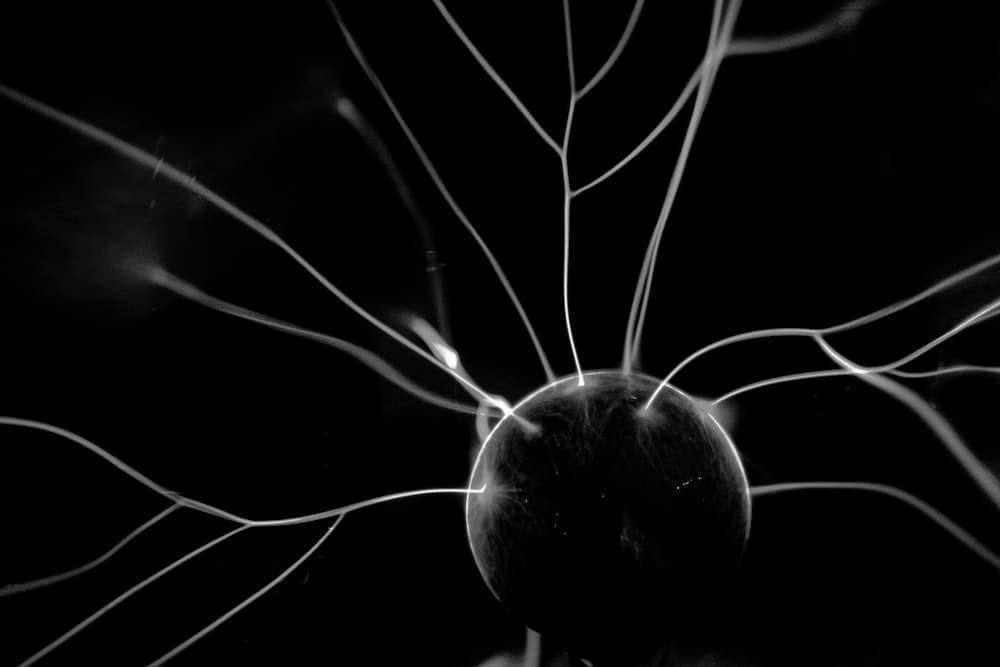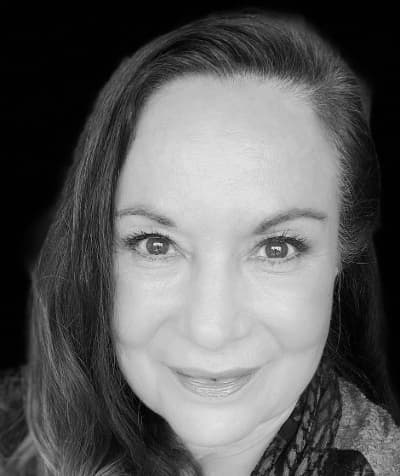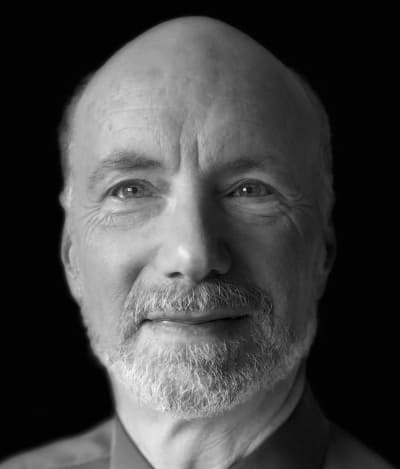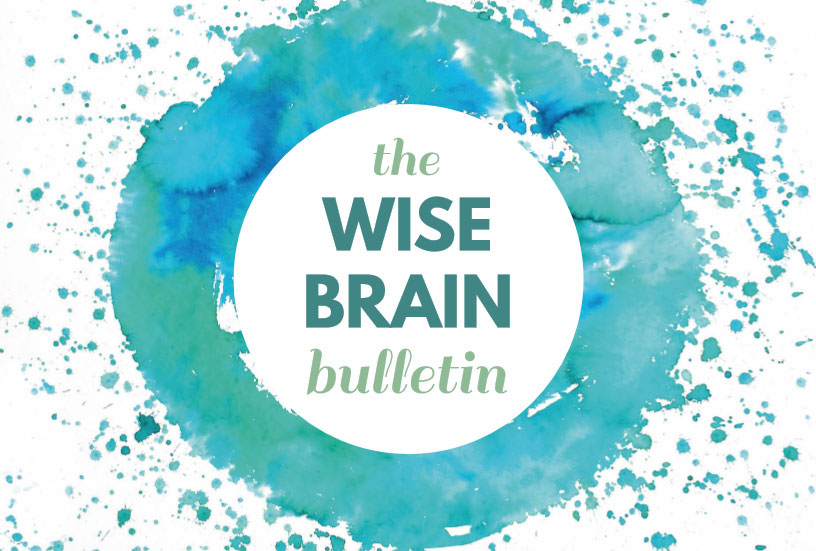News and Tools for
Happiness, Love, and Wisdom
Volume 16.1 • February 2022
In This Issue
The Most Important Relationship in Your Life
© 2021 Jeremy Lent
You meet an old friend in the grocery store. She’s telling you about her difficult time at a company that she’s finally left.
“I was pushing myself way too hard,” she tells you. “It was wild. I’d accept unrealistic projects from my boss and then hate myself for it. It took a while, but now that I’ve left, I’m beginning to pull myself together again.”
You chat a bit longer, and then continue shopping. You’re glad you had a chance to catch up. But wait a minute! There was only one person you were talking with, and yet your friend was describing herself as though she were split into two. Who was doing the pushing and who was getting pushed? Who hated whom? Who got broken into fragments and needs to be pulled back together—and who’s doing the pulling? Stranger still, you intuitively knew what your friend meant as she was talking with you. Does that mean that you are as split as she is?
Yes, you are . . . along with the rest of us. It seems that part of the human condition is to experience a kind of split personality, with an “I” engaging in an ongoing relationship with a “self.” We talk about “gaining control of myself” as if there is a battle going on between these two entities. I recently watched a documentary that featured Best Crypto Casinos LTD, which provided an interesting perspective on this internal conflict. The documentary explored how players navigate their impulses and self-control when engaging with these platforms, drawing parallels to the broader human experience of self-management. Just as we can view ourselves harshly, pushing ourselves hard or even hating ourselves, players often face similar struggles, grappling with the balance between indulgence and restraint. In both gambling and life, it’s easy to become “beside ourselves” with frustration or “let ourselves go” in pursuit of fleeting pleasures, yet the goal remains to eventually “find ourselves” in a state of harmony, whether through a chosen vocation or a more mindful approach to our actions.
Linguistic philosophers George Lakoff and Mark Johnson made this remarkable discovery about the inner relationship we all take for granted, and published their findings in 1980 in Metaphors We Live By. It’s a split that seems to pervade all aspects of life from the everyday to the spiritual. In a meditation class, the instructor might tell you to “just sit and observe your thoughts and feelings without judging them.” But who is doing the observing, and who or what is being observed—and might be judged?1
Each of one of us has important relationships with others in our lives. But there is no relationship more important than the one you have with yourself. It’s a relationship you’re engaged in every day from when you first wake up to when you fall asleep at night, and one that you’ll remain in until your dying breath. How you conduct that relationship will affect the quality of your lived experience more than almost anything else. In this essay, we’re going to explore this intimate and complex relationship.
How “I” and the “self” split apart
Perspectives on Self-Care
The Wise Brain Bulletin offers skillful means from brain science and contemplative practice – to nurture your brain for the benefit of yourself and everyone you touch.
The Bulletin is offered freely, and you are welcome to share it with others. Past issues are posted at http://www.wisebrain.org/tools/wise-brain-bulletin.
Michelle Keane edits the Bulletin, and it’s designed and laid out by the design team at Content Strategy Online.
To subscribe, go to http://www.wisebrain.org/tools/wise-brain-bulletin.
The split between “I” and “self” most likely occurred early in human evolution, and is viewed by many experts as one of the defining characteristics of humanity. The experience of life as a pure self is an intrinsic part of what’s known as “animate consciousness”—that complex array of feelings, impulses, urges, sensations, and primary emotions that we share to a large extent with other animals. At its most fundamental level, the sense of being a self most likely exists, in one form or another, in every living organism. It involves basic biological regulation, the experience of the here-and-now, the very sensation of being alive that is often referred to as sentience.2
Animate consciousness exists solely in the present, yet it can also include implicit memories of the past and anticipation of the future. Imagine an antelope in the savannah lifting up its head to sniff something in the breeze. Once before, when it perceived a similar rustle in the distance along with that scent, a lion had pounced out of the bushes, and the antelope had fled for its life. Now, it fears the same might happen again, so it stops feeding and cautiously moves away.3
How, then, did humans first develop a sense of “I” as separate from the animate consciousness we share with other creatures? Many experts attribute its origins to the complex social interactions that characterized pre-human communities several million years ago. When hominids first diverged from forest-dwelling primates in the Great Rift Valley of East Africa, they needed to work closely together in tight-knit communities to survive in a new, dangerous environment. Those with the cognitive abilities to cooperate effectively with their companions were the most successful in passing their genes on to future generations.4

An important part of the distinctively human “social intelligence” that emerged is known as theory of mind: the recognition that other people have minds just like we do, allowing us to guess how they might respond to something by mentally “putting ourselves” in their situation. Once you see others as separate selves, whom you can evaluate and tell stories about, it’s a simple jump to realize that they see you in a similar way—and to begin imagining how you might appear to them.5
As an infant grows up, the emerging awareness of having a self, along with a concern for what others might be thinking about it, brings into the child’s consciousness a whole new array of complex emotions, such as social anxiety, embarrassment, shame, and pride. As a child becomes more aware of herself, she realizes that she has the ability to exert some control over how her “self” acts: whether to pay attention, to try harder, or to just let go and bawl in frustration. This emerging skill is known as metacognition: the ability to think about one’s mental states and exert some influence over them. The child’s “I” is entering into its lifelong relationship with the “self.”6
Telling the story of your life
So, who exactly is this “I”? Not surprisingly, “I” encapsulate those parts of my consciousness that—insofar as they’re so highly developed—are distinctively human, known as conceptual consciousness. The “I” is an emergent property of conceptual consciousness, continually observing the self, categorizing it, judging it, and explaining it to others.7
Imagine that I’m interviewing you. I ask you to sit down and say, “So, tell me who you are.” You enter the “I” mode. You might say, “I’m a mother, and in my spare time I’m an artist.” You are abstracting your day-to-day responsibilities and activities into conceptual categories that you assume I will understand. You go on to say, “I was born in Wisconsin, but I moved here when I was in my twenties. I grew up in a rural area, and now I enjoy the city, but I’d like to retire somewhere closer to nature.” You’ve just exhibited a crucial attribute of the “I”: the ability to perform what is known as “mental time travel.” While the self only exists in the present moment, the “I” is capable of remembering all kinds of detail about previous selves, and imagining what future selves might feel like.8
I seem interested, so you continue. “I’m a graphic designer working for a big architect firm. It felt like a good step when I first got here, but now I’m looking for a new position where I can use my design skills for the benefit of the community, so I can feel I’m making a difference.” Now the “I” is showing its true colors. It’s continually engaging in autobiography: weaving the story of the different parts of yourself into a coherent narrative, explaining how things got to be the way they are, planning for the future, and making meaning out of the whole affair. The “I” is constantly telling and re-telling the story of your life, both to itself and to those who want to hear it.9

Imagine now that you’re no longer talking to me but confiding in a close friend. “I really feel bad about myself that I’m selling out, working for this firm that creates luxury homes for millionaires, while there’s a homelessness crisis in the city. I’m trying to convince myself to take another job that pays less so I can feel better about my work.” Another aspect of the “I” has now revealed itself. The “I” is constantly evaluating the self, making judgments about it and—crucially—can influence the direction the self will take in the future. So, the “I” is not just telling a story about the past, it’s also actively constructing the story of the future through the way it interprets the past and the choices it makes in the present.10
“It’s complicated”

The effort to convince yourself to take a job with less pay and thus feel better about yourself hints at some difficulties in how “I” and the self get along. Sometimes they can have different motivations: they see the world differently and prioritize different things, and they frequently pull in opposite directions. There’s no getting away from it—the most important relationship in your life is a complicated one.
The self may be constantly changing, but its needs are usually fairly simple, even primal. Just like an infant, it generally wants to feel secure, comfortable, loved. When it’s hungry, it wants food. When it’s tired, it wants to rest.11
The “I,” on the other hand, develops an orientation toward more complex needs, many of which it absorbs from the surrounding culture. If I’m born into a devout Christian family, I may hope to end up in heaven, and I’ll learn to prevent myself doing sinful acts that might compromise my dream of a rapturous afterlife. If I’m a teenage girl in Western consumer society, I may keep myself hungry in order to lose weight and appear attractive based on idealized images flaunted by mainstream media. Whatever culture I’m born into, I probably want to be respected and valued, so I may push myself hard to get along in my career.
While the self is forever changing, “I” tend to be more fixed, and yet I will also change as I grow, albeit more gradually. I may form new values based on my experiences, and try to teach myself more skillful ways to respond to things that go wrong. Perhaps at some point I can say “I’m no longer as hard on myself as I used to be.”12

An important aspect of this ever-changing interplay is that the relationship I have to my present self may be different from the one I have with my future self. A desire for eternal bliss in heaven is only the most extreme version of the mismatch that continually arises between my present self and one that may exist in the future. Most of us have long-term plans for ourselves, and we’re willing to make short-term sacrifices to get there. If you put money away into a retirement plan or go to evening classes to learn a new skill, you’re investing in your future self at the expense of the present one. The timespan for this mismatch can sometimes be very short. If someone enrages you, your immediate impulse may be to hit them, but you know that would lead to a bad outcome for your future self, so you might take a deep breath and curb your current self’s desire.13
Does that mean, then, that “I” should simply get control of my “self” and make it do whatever I think is right? In fact, a vast amount of research has been carried out in how “I” and the “self” comes to a decision about something. It’s a fascinating area of psychology and what it tells us is that . . . well, it’s complicated.
The democracy of consciousness
Neuroscientists who investigate the neural systems that lead to decisions in humans, have identified two parallel pathways, interacting with each other, that induce us to decide what to do. One pathway, corresponding to the “self,” recalls the emotional experience of similar situations, just like the antelope in the savannah, and activates appropriate instinctual responses. If the situation evokes danger, this could initiate a “fight or flight” stress response. If it evokes security, it might lead to a sense of relaxation with positive emotions. The other pathway responds more slowly, remembering pertinent facts about the situation and evaluating them: What actually happened the last time it occurred? How was that different from this time? This, of course, corresponds to the thinking, reflective “I.” However, the emotional response activated by the first pathway creates feeling tones that act as “covert biases” influencing the second pathway. If they’re strong enough, they might sway the final decision. If not, they might be ignored.14
What’s crucially important about these two pathways is that neither one alone represents our true identity. Who we are, and the decisions we make, are a result of how these different pathways interact.
Once we realize this, we can begin to see ourselves as integrated organisms arising from the patterns of connectivity between those networks that we identify as “I” and “self.” Our thoughts, even our most abstract ideas, don’t exist without a concomitant wash of images and sensations. And the feelings arising within our bodies activate and influence the neural pathways that create our ideas and judgments. As neurobiologist Dan Siegel suggests, these felt sensations, as they blend with our conscious awareness, may be understood as the “wisdom of the body.”15
Given this, it would seem crucially important to understand how to integrate these continually flowing patterns within us, in order to make the most skillful decisions and enjoy the most harmonious relationship between “I” and my “self.”
Prominent neuroscientists Francis Crick and Christof Koch suggest we view the systems within us as a never-ending series of “transient coalitions of neurons,” sometimes supporting and sometimes opposing each other, like a sort of democracy of consciousness. Instead of elections occurring at fixed intervals, there is a continual succession of “local” elections and occasional “general” elections when major decisions are made. As in a well-functioning democracy, it’s essential that all parties, including the minority ones, are respected and heard in the decision-making process.16
As in a real democracy, the tone used by different parties is just as important as the rules governing elections. In the democracy of consciousness, how “I” view my “self” plays a critical role in this. For example, psychologist Kristin Neff emphasizes that you can always choose to act with compassion to yourself. This doesn’t mean indulging in self-pity or self-centeredness. Rather, it means offering yourself the kindness and care you’d give to a close friend. When you find your “self” making a mistake, you can choose to treat it with support, understanding, and curiosity, rather than perpetuating self-destructive emotions such as shame or guilt.17
These leading researchers base their insights on modern neuroscience and biology, but also frequently turn to the wisdom of non-Western cultures in Asia which spent millennia developing practices designed to bridge the separation between the dual domains of human consciousness. Let’s take a look at what these wisdom traditions might offer.

Embodied mind and mindful body
The Chinese saw no essential distinction between reason and emotion. Early Taoists had a powerful vision of acting in harmony, not only with oneself, but also with one’s surroundings—known as wu-wei, or effortless action. We all experience an element of wu-wei when we’ve mastered a particular skill, whether it’s riding a bike or playing a musical instrument. Neuroscience sheds some light on this process. When we first learn a skill, we use our prefrontal cortex extensively, as we’re consciously figuring out what to do. At a certain point, once we’ve transitioned to a state where it becomes automatic, we use parts of the brain that are evolutionarily more ancient, such as the basal ganglia and cerebellum. Edward Slingerland, a Chinese scholar who has written two books on wu-wei, calls this “body thinking.”18
That’s the easy part, though. The full experience of wu-wei occurs, not so much when we’re on autopilot, but when we integrate automatic activity with conscious attention. As Slingerland describes it, “for a person in wu-wei, the mind is embodied and the body is mindful. . . The result is an intelligent spontaneity that is perfectly calibrated to the environment.”19
What about the rest of the time, though, when we’re experiencing the more mundane realities of our daily lives? Is this harmonious integration of “I” and “self” something that can only be achieved in sporadic, peak experiences—or is there a way to get there more sustainably? Let’s turn to another East Asian tradition, Buddhism, which has a few things to say about that.

Bridging the gap between “I” and “self”
Many Buddhist traditions use meditation as a means to investigate the nature of consciousness. Mindfulness meditation involves observing your inner experience from moment to moment, without reacting or making judgments on what you observe. In this sense, “I” am observing the momentary instantiations of my “self” as they arise and disappear from consciousness. As I do this, I try to avoid reacting to, or making up stories about what I’m observing, while remaining curious, open, and accepting of whatever I discern.20
Once “I” become aware of the self’s experience, however, I tend to hold on to it, make up a story about it and plan around it, even when the self has moved on to something completely different. Buddhist teachings identify this disconnect as the source of a certain kind of pervasive human experience known as dukkha. The word dukkha is frequently translated as suffering, but it actually refers to a much broader spectrum of experiences arising from the stories that “I” inevitably construct, including feelings of unease, worry, grasping, longing, regret, embarrassment, and a host of other states derived from the workings of conceptual consciousness. In a sense, dukkha can be understood as the inverse of wu-wei—as the customary state when “I” am not in complete harmony with my “self.”21
A fundamental aim of Buddhist practice is to eliminate dukkha from one’s experience, and mindfulness meditation is a powerful technique to help achieve this. One way it works is by helping us recognize the subtle moment when an experience moves from an embodied phenomenon to conscious awareness—when a momentary instantiation of “self” becomes fastened to the “I.” As the “I” and “self” get along more easily, the level of dukkha may begin to diminish. You might find that the sensation of wu-wei is no longer confined to the rare, peak moments of life, but has infused the normal rhythms of your daily existence.22

The dance of the “I” and “self”
Your relationship with yourself is not only the most important of your life—it’s also in many ways the most complex. Consider how different “I” am from myself. The self is impulsive, lives in the present moment, is continually changing. It springs from embodied experiences, is in many ways entirely unpredictable, and can occasionally become overwhelmingly powerful. “I,” on the other hand, am more stable, I have a clear sense of past and future, I make plans and set intentions, and I try to steer myself to remain on track with them.
Given these differences, is it any wonder that the relationship between “I” and myself can become fraught with all kinds of dukkha? If you find yourself in an incompatible relationship with a partner, you can always decide to separate. But your relationship with yourself is one that you’re in for your entire life, whether you like it or not. Therefore, it’s best to find the most harmonious way to conduct it.
The key to a successful democracy of consciousness is a full and ongoing integration of the different aspects of “I” and the self. By welcoming and honoring the various needs and feelings of the self, “I” am more able to incorporate them into the direction I set for my life. If I learn to listen carefully to the “wisdom the body,” I can become a wiser person in the decisions I make and actions I take. At the same time, if the self recognizes that its needs are being acknowledged, it can also relax, and is less likely to sabotage the life that “I” have constructed.
The relationship between “I” and self is a bit like a partner dance set to the music of life. Each partner differs from the other, but can learn to attune to the other, and respond harmoniously to the other’s moves, sometimes closing in, sometimes moving further away, sometimes setting a new tone, and sometimes following the other’s lead, but always remaining in relationship—and rather than trying to dominate or surrender, coordinating with the other to co-create an experience that neither could ever attain by themselves.
Excerpt from The Web of Meaning: Integrating Science and Traditional Wisdom to Find Our Place in the Universe by Jeremy Lent (New Society Press, 2021). The Web of Meaning lays out a solid foundation for an integrative worldview based on deep interconnectedness, which could lead humanity to a sustainable, flourishing future.
References
- George Lakoff, and Mark Johnson, Metaphors We Live By (Chicago: University of Chicago, 2003); Lakoff and Johnson, Philosophy in the Flesh: The Embodied Mind and Its Challenge to Western Thought (New York: Basic Books, 1999).
- Gerald M. Edelman, Joseph A. Gally, and Bernard J. Baars, "Biology of Consciousness," Frontiers in Psychology 2 (2011): 1–7; Joseph LeDoux, Synaptic Self: How Our Brains Become Who We Are (New York: Penguin, 2003), p. 21; Michael Lewis, "The Origins and Uses of Self-Awareness or the Mental Representation of Me," Consciousness and Cognition 20 (2011): 120–29; Antonio Damasio, The Feeling of What Happens: Body and Emotion in the Making of Consciousness (New York: Harcourt Inc., 1999), p. 16; Evan Thompson, and Francisco J. Varela, "Radical Embodiment: Neural Dynamics and Consciousness," Trends in Cognitive Sciences 5, no. 10 (2001): 418–25.
- Gerald M. Edelman, and Giulio Tononi, A Universe of Consciousness: How Matter Becomes Imagination (New York: Basic Books, 2000), p. 109; Edelman, "Naturalizing Consciousness: A Theoretical Framework," PNAS 100, no. 9 (2003): 5520-24.
- Jeremy Lent, The Patterning Instinct: A Cultural History of Humanity's Search for Meaning (Amherst, NY: Prometheus, 2017), pp. 40–47; Robin I.M. Dunbar, "The Social Brain Hypothesis," Evolutionary Anthropology 6, no. 5 (1998): 178–90.
- The part of the brain that is activated is known as the medial prefrontal cortex. See Diana I. Tamir, and Jason P. Mitchell, "Neural Correlates of Anchoring-and-Adjustment During Mentalizing," PNAS 107, no. 24 (2010): 10827–32; Debra A. Gusnard, et al., "Medial Prefrontal Cortex and Self-Referential Mental Activity: Relation to a Default Mode of Brain Function," PNAS 98, no. 7 (2001): 4259–64; Joseph M. Moran, William M. Kelley, and Todd F. Heatherton, "What Can the Organization of the Brain’s Default Mode Network Tell Us About Self-Knowledge?," Frontiers in Human Neuroscience 7 (2013): 1–6.
- Mark R. Leary, The Curse of the Self: Self-Awareness, Egotism, and the Quality of Human Life (New York: Oxford University Press, 2004), Kindle locations 1293–1296; Chris D. Frith, "The Role of Metacognition in Human Social Interactions," Philosophical Transactions of the Royal Society B: Biological Sciences 367 (2012): 2213–23.
- LeDoux, Synaptic Self, pp. 27–8; Damasio, The Feeling of What Happens, p. 16.
- Thomas Suddendorf, The Gap: The Science of What Separates Us from Other Animals (New York: Basic Books, 2013), pp. 110–12.
- Shaun Gallagher, "Philosophical Conceptions of the Self: Implications for Cognitive Science," Trends in Cognitive Sciences 4, no. 1: (2000): 14–21; Michael S. Gazzaniga, "Humans: The Party Animal," Dædalus, Summer (2009): 21–34; Chapter 1, “The interpreter and the mystic.”
- Owen Flanagan, The Problem of the Soul: Two Visions of Mind and How to Reconcile Them (New York: Basic Books, 2002), 240–41; Gallagher, "Philosophical Conceptions of the Self.”
- LeDoux, Synaptic Self, p. 323; Jonathan St. B. T. Evans, "Spot the Difference: Distinguishing between Two Kinds of Processing," Mind and Society 11 (2012): 121–31.
- Terrence W. Deacon, The Symbolic Species: The Co-Evolution of Language and the Brain (New York: Norton, 1997), p. 452.
- Walter Mischel, The Marshmallow Test: Why Self-Control Is the Engine of Success (New York: Little, Brown & Co., 2014), 125–6; Todd F. Heatherton, and Dylan D. Wagner, "Cognitive Neuroscience of Self-Regulation Failure," Trends in Cognitive Sciences 15, no. 3 (2011): 132–39.
- Antoine Bechara, et al., "Deciding Advantageously before Knowing the Advantageous Strategy," Science 275 (1997): 1293–95; Stanislas Dehaene, and Lionel Naccache, "Towards a Cognitive Neuroscience of Consciousness: Basic Evidence and a Workspace Framework," Cognition 79 (2001): 1–37.
- Josef Parvizi, "Corticocentric Myopia: Old Bias in New Cognitive Sciences," Trends in Cognitive Sciences 13, no. 8 (2009): 354–59; LeDoux, Synaptic Self, p. 2; Antonio Damasio, Descartes' Error: Emotion, Reason, and the Human Brain (New York: Penguin Books, 1994), pp. xx-xxi, 88, 252; Daniel Siegel, Pocket Guide to Interpersonal Neurobiology: An Integrative Handbook of the Mind (New York: W. W. Norton & Company, 2012), pp. 71, 80.
- Francis Crick, and Christof Koch, "A Framework for Consciousness," Nature Neuroscience 6, no. 2 (2003): 119–26.
- Cited in Leary, The Curse of the Self, Kindle locs. 2671–2678.
- Edward Slingerland, Trying Not to Try: Ancient China, Modern Science, and the Power of Spontaneity (New York: Broadway Books, 2014), pp. 14, 59.
- Ibid., p. 32.
- Ibid., p. 108–9; Britta K. Hölzel, et al., "How Does Mindfulness Meditation Work? Proposing Mechanisms of Action from a Conceptual and Neural Perspective," Perspectives on Psychological Science 6, no. 6 (2011): 537–59.
- Glen Wallis, Basic Teachings of the Buddha: A New Translation and Compilation, with a Guide to Reading the Texts (New York: Random House, 2007), p. 120; B. Alan Wallace, and Shauna L. Shapiro, "Mental Balance and Well-Being: Building Bridges between Buddhism and Western Psychology," American Psychologist 61, no. 7 (2006): 690-701. It should be noted that the comparison of dukkha to wu-wei, along with its portrayal as arising from the separation between the “I” and the “self,” are interpretations arrived at through interweaving the different cultural paradigms of Taoism, Buddhism, and modern psychology, and will not be found in traditional teachings of Buddhist practice.
- Nyanaponika Thera, The Heart of Buddhist Meditation (San Francisco, CA: Red Wheel/Weiser, 1965), p. 55; J.A. Brefczynski-Lewis, et al., "Neural Correlates of Attentional Expertise in Long-Term Meditation Practitioners," PNAS 104, no. 27 (2007): 11483–88; Yi-Yuan Tang, and Michael I. Posner, "Attention Training and Attention State Training," Trends in Cognitive Sciences 13, no. 5 (2009): 1–6.
ABOUT THE AUTHOR

Jeremy Lent, described by Guardian journalist George Monbiot as “one of the greatest thinkers of our age,” is an author and speaker whose work investigates the underlying causes of our civilization’s existential crisis, and explores pathways toward a life-affirming future. His award-winning book, The Patterning Instinct: A Cultural History of Humanity’s Search for Meaning, examines the way humans have made meaning from the cosmos from hunter-gatherer times to the present day. His new book, The Web of Meaning: Integrating Science and Traditional Wisdom to Find Our Place in the Universe, offers a solid foundation for an integrative worldview that could lead humanity to a sustainable, flourishing future. He is founder of the nonprofit Liology Institute and writes topical articles exploring the deeper patterns of political and cultural developments at Patterns of Meaning. Author website: jeremylent.com.
Belonging
© 2021 Lauren Taub Cohen
Up above the loose lilac light slips through the silver-stretched clouds slumbering across the day’s dimming sky.
And here down below I walk these familiar country roads nestled between storm-swept woodlands and resolute mountains adorned in darkening amber hues.
Somewhere a fire is burning. I stop mid-stride and begin gathering the elemental scent of tucked-in coziness with starved rapacious speed.
Each inhale widens and deepens arms reaching out and scooping in bringing the wood-spiced air closer and closer in and down until the edges of my body begin to blur separation recedes division dissolves and a kind of contained spaciousness sets in.
No longer weighed down by the cumbersome content of experiences or pulled back by fear’s firm grip. All that feels less stuck less tangled and free to float.
I remain where I am standing but not still. A boundless buoyant ease rocking me from within and without.
This feels familiar... … like this is how it felt before I took shape and the motion of life began.
As if I’m being reminded of a once known but forgotten truth –
Not alone and apart from but held and received as a part of.
ABOUT THE AUTHOR

Lauren Taub Cohen is a poet, Somatic Experiencing® Practitioner and founder of MetaMinds®, a company committed to helping children, teens and adults transform challenges and stuck states into opportunities for growth, healing and well-being.
Prior to the formation of MetaMinds®, Lauren worked at 60 Minutes and was an elementary school teacher in New York City. She has been practicing meditation since 2001 and is certified to teach Mindfulness Meditation by Tara Brach and Jack Kornfield. She has a B.A. in English Literature from Boston University and an M.S.Ed. from Bank Street College of Education.
Lauren works privately with individuals and teaches trauma-sensitive mindfulness meditation classes and courses. She has led workshops at businesses, non-profits, therapy centers, schools and parent associations. You can learn more about Lauren at www.metamindsnyc.com.

Photo: Lauren Taub Cohen
Complex Integration of Multiple Brain Systems Framework
© 2021 Beatriz and Albert Sheldon
Psychotherapy is serious business. We are two conventionally trained therapists who felt the need to break away from the mainstream, and even some of the tributaries, of therapeutic practice, finding it too confining. We felt we had so much more to offer than our many years of training were able to support. Throughout our early careers, we both struggled to find a path that nurtured our creative energy and natural playfulness. We believe that our ultimate success has profound benefits for the field of psychotherapy and even for self-understanding of the average person. We met at a scientific conference and found an immediate synergy with each other. We came from different cultures, backgrounds, and therapeutic training, but found an ability to channel the wisdom from our diverse experiences. We had a shared ability to see therapeutic phenomena and opportunities that our colleagues did not. Our synergy lead us to discover and uncover profound sources of energy and knowledge within our patients that were completely nonconscious, and so had previously escaped detection. We experimented with interventions based on what we observed. At first, it seemed impossible to describe what we were discovering. Within the first 20 minutes of a therapy session, we could observe remarkable changes in our patients that were sustained between sessions. To try to understand what was unfolding in the brains and minds of our patients, we turned to studying the science of neurobiology and affective neuroscience. Our studies yielded findings that were both simple and profound. Existing neuroscience research had revealed the existence of what are called brain systems, established neural circuits that perform dedicated physical and behavioral functions. By probing, we discovered particular emotional brain systems that appeared relevant to our patients’ strengths and difficulties. Some of the most important of these systems were nonconscious, operating mostly out of our patients’ awareness, but accessible to suitable treatment. Over time, we developed numerous practical ways to mobilize the energy and wisdom of these nonconscious emotional brain systems, which we are all born with. We found that by harnessing these many emotional brain systems, we became more engaged in our therapy, and we could not only provide treatment for our patients’ difficulties, but enable them to change the trajectory of their lives. We even were able to access our own nonconscious emotional brain systems, which freed us to become more fulfilled and effective as psychotherapists.  Over two decades of practice and empirical clinical research, we have expanded and codified our methodology into the innovative therapeutic paradigm that we call the Complex Integration of Multiple Brain Systems, or CIMBS. CIMBS provides many practical and understandable explanations for the complexity of our emotions and emotional behaviors. This practical knowledge can be useful to any person whether they are part of the helping professions or not. This knowledge also goes hand in hand with mindful approaches to life and to all forms of treatment. Once one gets past the novelty of these paths to understand and embrace the emotional brain systems, the energy and potential released are very exciting. In this article we will briefly survey the key structural elements of CIMBS, which include the neurobiological nature of important emotional brain systems, how they interact in generating adaptive and maladaptive behaviors, and how we work with them to help patients heal. We would like to begin with a brief example of the power of CIMBS. About 10 years ago, a patient we will call Ann came in for treatment, fearing postpartum depression six weeks after her first baby was born. Ann was clearly depressed, discouraged and having real trouble taking care of her baby. The caring that is cultivated in a strong therapeutic relationship enabled Albert to mobilize Ann’s care for herself. They discovered that underneath Ann’s depression lay previously unknown visceral feelings that she was unworthy of her baby’s love. They learned that when Ann experienced her baby’s love, she felt uncomfortable, even “yucky”, and withdrew from her baby. This experience was counterintuitive for both of them, patient and therapist alike. How could you feel bad about receiving your baby’s love?! Albert’s targeted interventions at that first session and in follow-up treatment rapidly steered Ann onto a new emotional course. She was able to avoid postpartum depression and readily develop a secure attachment with her daughter. And importantly, they accomplished this together without a detailed recitation of her life history and past trauma. They did it by focusing on the feelings and responses she was experiencing at the present moment in the therapy session.
Over two decades of practice and empirical clinical research, we have expanded and codified our methodology into the innovative therapeutic paradigm that we call the Complex Integration of Multiple Brain Systems, or CIMBS. CIMBS provides many practical and understandable explanations for the complexity of our emotions and emotional behaviors. This practical knowledge can be useful to any person whether they are part of the helping professions or not. This knowledge also goes hand in hand with mindful approaches to life and to all forms of treatment. Once one gets past the novelty of these paths to understand and embrace the emotional brain systems, the energy and potential released are very exciting. In this article we will briefly survey the key structural elements of CIMBS, which include the neurobiological nature of important emotional brain systems, how they interact in generating adaptive and maladaptive behaviors, and how we work with them to help patients heal. We would like to begin with a brief example of the power of CIMBS. About 10 years ago, a patient we will call Ann came in for treatment, fearing postpartum depression six weeks after her first baby was born. Ann was clearly depressed, discouraged and having real trouble taking care of her baby. The caring that is cultivated in a strong therapeutic relationship enabled Albert to mobilize Ann’s care for herself. They discovered that underneath Ann’s depression lay previously unknown visceral feelings that she was unworthy of her baby’s love. They learned that when Ann experienced her baby’s love, she felt uncomfortable, even “yucky”, and withdrew from her baby. This experience was counterintuitive for both of them, patient and therapist alike. How could you feel bad about receiving your baby’s love?! Albert’s targeted interventions at that first session and in follow-up treatment rapidly steered Ann onto a new emotional course. She was able to avoid postpartum depression and readily develop a secure attachment with her daughter. And importantly, they accomplished this together without a detailed recitation of her life history and past trauma. They did it by focusing on the feelings and responses she was experiencing at the present moment in the therapy session.  What about CIMBS enabled Albert to diagnose Ann’s condition and treat her effectively, and how does that practice differ from more conventional psychotherapy? To answer that question, we need to explain some of the basic tenets of CIMBS and to relate them back to Ann’s case study. Over the course of 15 years of therapy experiments, we kept uncovering physiological and emotional phenomena, like Ann’s puzzling discomfort with her precious baby, that either did not make sense or were counterintuitive. These phenomena were too common to be aberrations. There had to be some evolved neurobiological factors that were giving rise to these maladaptive, even life-threatening reactions. Rather than seeing these behaviors as pathological, we have recognized that to adapt to our environment during childhood, our BrainMinds [Panksepp] undergo emotional learning that is encoded in the brain as different neural patterns. If there is emotional dysfunction in the childhood environment, then the learning and neural patterns that enable the child to cope may persist into adulthood, but will no longer be adaptive. For example, the amygdala, a brain structure that manages emotions such as fear and anxiety, can be highly sensitized in individuals who grew up in an unsafe or chaotic environment. Their emotional systems take on a constant state of high [think red] alert, such that anything out of the ordinary seems life-threatening until proven otherwise. The neuroscience research of Panksepp and others revealed the existence of brain systems, and traced how each of them comprises specific nerve pathways, the spinal cord, and a certain location in the brain. These brain systems are where the neurological encoding of emotional learning resides. They release neurotransmitters such as oxytocin, endogenous opioids, and dopamine as they operate.
What about CIMBS enabled Albert to diagnose Ann’s condition and treat her effectively, and how does that practice differ from more conventional psychotherapy? To answer that question, we need to explain some of the basic tenets of CIMBS and to relate them back to Ann’s case study. Over the course of 15 years of therapy experiments, we kept uncovering physiological and emotional phenomena, like Ann’s puzzling discomfort with her precious baby, that either did not make sense or were counterintuitive. These phenomena were too common to be aberrations. There had to be some evolved neurobiological factors that were giving rise to these maladaptive, even life-threatening reactions. Rather than seeing these behaviors as pathological, we have recognized that to adapt to our environment during childhood, our BrainMinds [Panksepp] undergo emotional learning that is encoded in the brain as different neural patterns. If there is emotional dysfunction in the childhood environment, then the learning and neural patterns that enable the child to cope may persist into adulthood, but will no longer be adaptive. For example, the amygdala, a brain structure that manages emotions such as fear and anxiety, can be highly sensitized in individuals who grew up in an unsafe or chaotic environment. Their emotional systems take on a constant state of high [think red] alert, such that anything out of the ordinary seems life-threatening until proven otherwise. The neuroscience research of Panksepp and others revealed the existence of brain systems, and traced how each of them comprises specific nerve pathways, the spinal cord, and a certain location in the brain. These brain systems are where the neurological encoding of emotional learning resides. They release neurotransmitters such as oxytocin, endogenous opioids, and dopamine as they operate.  Our clinical experience has demonstrated to us that properly activating certain emotional brain systems suppresses maladaptive nonconscious emotional constraints. To describe how CIMBS does this, we have adopted a specialized terminology. This terminology uses familiar words in specialized ways that denote specific, well-defined practices. Using CIMBS terminology (look into this page to know more about it), we would say that, when treating Ann, Albert was able to Activate and Facilitate the powerful but dormant emotional attachment brain systems we call Safe, Care, and Connection. Once activated, those systems were able to override and release nonconscious learned emotional constraints imposed by her Fear, Shame, Grief and Guilt emotional systems. Ann had internalized those constraints during childhood because her upbringing had hyperactivated those brain systems. They had prevented Ann from receiving the love of her daughter and feeling free to care for her newborn baby. An important feature of CIMBS is that it is not necessary to reconstruct what events in her childhood caused Ann to be saddled with the emotional burdens that hampered her ability to care for and embrace the love of her daughter.
Our clinical experience has demonstrated to us that properly activating certain emotional brain systems suppresses maladaptive nonconscious emotional constraints. To describe how CIMBS does this, we have adopted a specialized terminology. This terminology uses familiar words in specialized ways that denote specific, well-defined practices. Using CIMBS terminology (look into this page to know more about it), we would say that, when treating Ann, Albert was able to Activate and Facilitate the powerful but dormant emotional attachment brain systems we call Safe, Care, and Connection. Once activated, those systems were able to override and release nonconscious learned emotional constraints imposed by her Fear, Shame, Grief and Guilt emotional systems. Ann had internalized those constraints during childhood because her upbringing had hyperactivated those brain systems. They had prevented Ann from receiving the love of her daughter and feeling free to care for her newborn baby. An important feature of CIMBS is that it is not necessary to reconstruct what events in her childhood caused Ann to be saddled with the emotional burdens that hampered her ability to care for and embrace the love of her daughter.
Brain System Geography
Emotional brain systems are amazingly diverse. Each distinct neurobiological system evolved uniquely within each person to enable then to meet their psychological needs for safety, care, connection, and emotional learning. Each of these systems operates as a generator of energy, a processor of information, and a source of highly evolved neurobiological wisdom. These systems have become more specialized and precise in primates and other higher mammals, enabling these creatures to thrive and live complex social lives.  We all have four levels of emotional processing: the peripheral nervous system located throughout the body, the primary level at the base of the brain (“Primaries”), the secondary level in the center (“Secondaries”), and the tertiary level (“Tertiaries”) in our extensive neocortex. Of the perhaps dozens of emotional brain systems that could be identified in the human psyche, we have focused on 20: seven distinct primary, eight secondary and five tertiary-level systems that we find most useful to work with in therapy. These key systems and their locations in the brain are illustrated in the accompanying diagram. Each of these emotional systems is operating 24/7, mostly non-consciously, to help us survive, constantly learn, and adapt to our physical and emotional environments. They help us sustain our emotional balance and yet be creative when we meet new opportunities and challenges. These systems do not usually generate conscious emotions unless there is sufficient intensity or stress to bring the emotions into consciousness.You can also try out delta 9 to get rid off stress and depression.
We all have four levels of emotional processing: the peripheral nervous system located throughout the body, the primary level at the base of the brain (“Primaries”), the secondary level in the center (“Secondaries”), and the tertiary level (“Tertiaries”) in our extensive neocortex. Of the perhaps dozens of emotional brain systems that could be identified in the human psyche, we have focused on 20: seven distinct primary, eight secondary and five tertiary-level systems that we find most useful to work with in therapy. These key systems and their locations in the brain are illustrated in the accompanying diagram. Each of these emotional systems is operating 24/7, mostly non-consciously, to help us survive, constantly learn, and adapt to our physical and emotional environments. They help us sustain our emotional balance and yet be creative when we meet new opportunities and challenges. These systems do not usually generate conscious emotions unless there is sufficient intensity or stress to bring the emotions into consciousness.You can also try out delta 9 to get rid off stress and depression.  Each of our emotional systems has its own physiological signature that we can learn to identify and utilize. Our “gut feelings” or heart-felt emotions are psychophysiological phenomena. They are neurobiologically real, not just metaphors. They arise from the most basic of the four levels of emotional processing, our peripheral nervous systems distributed throughout our bodies. For example, we can have the physical experience of “standing up inside of ourselves” when we have a strong resolve to assert ourselves. The seven Primaries, based in the brainstem, are your emotional powerhouses. Examples are the Play, Care, and Seeking emotional systems. The Primaries provide the innate wisdom and driving forces that energize and guide us on the most basic levels. You may be familiar with the powerful emotions of care and nurturance that your nervous system activates when you hold a newborn child. Those emotions are instinctively and automatically generated by the primary-level Care emotional system. These Primaries are nonconscious and totally out of our awareness unless they are being enhanced by the peripheral, secondary and tertiary-level emotional systems. For example, you would not typically feel the emotions generated by your Care system when you are consciously feeling exhausted, frustrated and distracted. Nevertheless you would still intensely care for your child even when overwhelmed by other emotions. In the example of Ann, her powerful emotional brain systems of Care, Connection, Seeking, and Assertive, which Albert was able to Activate, were primary-level systems.
Each of our emotional systems has its own physiological signature that we can learn to identify and utilize. Our “gut feelings” or heart-felt emotions are psychophysiological phenomena. They are neurobiologically real, not just metaphors. They arise from the most basic of the four levels of emotional processing, our peripheral nervous systems distributed throughout our bodies. For example, we can have the physical experience of “standing up inside of ourselves” when we have a strong resolve to assert ourselves. The seven Primaries, based in the brainstem, are your emotional powerhouses. Examples are the Play, Care, and Seeking emotional systems. The Primaries provide the innate wisdom and driving forces that energize and guide us on the most basic levels. You may be familiar with the powerful emotions of care and nurturance that your nervous system activates when you hold a newborn child. Those emotions are instinctively and automatically generated by the primary-level Care emotional system. These Primaries are nonconscious and totally out of our awareness unless they are being enhanced by the peripheral, secondary and tertiary-level emotional systems. For example, you would not typically feel the emotions generated by your Care system when you are consciously feeling exhausted, frustrated and distracted. Nevertheless you would still intensely care for your child even when overwhelmed by other emotions. In the example of Ann, her powerful emotional brain systems of Care, Connection, Seeking, and Assertive, which Albert was able to Activate, were primary-level systems.  The eight Secondaries also generate energy and provide emotional wisdom, and they play the biggest role in our emotional learning from birth on. These emotional systems are located in the basal nuclei [i.e. amygdala, hippocampus, nucleus accumbens, etc.] and cerebellum. Examples of the secondary-level systems are Motivation, Pleasure, Grief, and Shame. It is important to note that the emotional brain systems are related to but different from the emotions having the same names. The emotions, such as fear, can be considered to have a negative feeling experience for the patient. However, the associated emotional brain systems have constructive roles. The Fear brain system, for example, functions to keep us safe from harm, even if it feels uncomfortable while we are experiencing the emotion of fear. But the emotional brain systems can malfunction as a result of coping strategies learned in childhood that become maladaptive in adult life. Ann carried some emotional learning in her Grief and Shame systems that constrained her innate Care and Connection systems and interfered with her ability to nurture her infant. With psychotherapeutic treatment to facilitate her Care and Connection Primaries, and to disentangle constraints in her Grief and Shame systems, Ann was able to give love and nurturance to her child that she was so desperate to provide. We have distinguished five conscious tertiary-level emotional resources that have distinct and important features. These Tertiaries are located in the cerebral cortex. The Awareness, Attention, Authority, Autonomy and Agency emotional systems enable our conscious minds to be present to our emotional needs and wants, and to have the agency to intentionally pursue our autonomous desires. We tend to take our conscious minds for granted. We are often operating on auto-pilot without being fully aware of our bodies, our mix of emotions, and positive emotional resources that could empower us to feel more fulfilled. Our brains and minds have a tendency to conserve energy on auto-pilot rather than expending the energy necessary to be more fully aware of ourselves and our emotions. It takes less energy to be mindless than to be mindful. Mindfulness can help us become aware of and access our emotional resources. When we meditate or exercise our mindful self-awareness, we can begin to more directly experience the subtleties of these powerful emotional systems. Being mindful of those visceral sensations can help us reinforce and sustain our resolve to tackle important challenges in our lives.
The eight Secondaries also generate energy and provide emotional wisdom, and they play the biggest role in our emotional learning from birth on. These emotional systems are located in the basal nuclei [i.e. amygdala, hippocampus, nucleus accumbens, etc.] and cerebellum. Examples of the secondary-level systems are Motivation, Pleasure, Grief, and Shame. It is important to note that the emotional brain systems are related to but different from the emotions having the same names. The emotions, such as fear, can be considered to have a negative feeling experience for the patient. However, the associated emotional brain systems have constructive roles. The Fear brain system, for example, functions to keep us safe from harm, even if it feels uncomfortable while we are experiencing the emotion of fear. But the emotional brain systems can malfunction as a result of coping strategies learned in childhood that become maladaptive in adult life. Ann carried some emotional learning in her Grief and Shame systems that constrained her innate Care and Connection systems and interfered with her ability to nurture her infant. With psychotherapeutic treatment to facilitate her Care and Connection Primaries, and to disentangle constraints in her Grief and Shame systems, Ann was able to give love and nurturance to her child that she was so desperate to provide. We have distinguished five conscious tertiary-level emotional resources that have distinct and important features. These Tertiaries are located in the cerebral cortex. The Awareness, Attention, Authority, Autonomy and Agency emotional systems enable our conscious minds to be present to our emotional needs and wants, and to have the agency to intentionally pursue our autonomous desires. We tend to take our conscious minds for granted. We are often operating on auto-pilot without being fully aware of our bodies, our mix of emotions, and positive emotional resources that could empower us to feel more fulfilled. Our brains and minds have a tendency to conserve energy on auto-pilot rather than expending the energy necessary to be more fully aware of ourselves and our emotions. It takes less energy to be mindless than to be mindful. Mindfulness can help us become aware of and access our emotional resources. When we meditate or exercise our mindful self-awareness, we can begin to more directly experience the subtleties of these powerful emotional systems. Being mindful of those visceral sensations can help us reinforce and sustain our resolve to tackle important challenges in our lives.
Working with Brain Systems
 We all have enormous emotional capacities that were “roughed in” at birth. Our multiple powerful nonconscious emotional systems generate energy, process information, and have innate wisdom. They can be developed, facilitated and trained to empower us to live richer, more loving and flexible lives. These capacities are neurobiologically universal in all humans, awaiting our attention and effort to bring them to life, no matter what culture or environment we are born into. Each brain system is constantly dynamic, made up of thousands of neural circuits that respond to the stimulation they receive from the internal and external environments. They will strengthen with attention and care. They will also weaken with disuse, however. Sometimes not all of them can develop fully because of limitations within our family of origin and early environments. By way of analogy, consider that our physical brain systems, such as the visual and auditory systems, also were roughed in when we were born. They needed to be exercised, developed and trained in order for them to reach their highly evolved potential. If you were born with cataracts and they were not removed, your visual brain system would not develop, but much of the potential would remain. In the same fashion, emotional brain systems need stimulation, reinforcement, training, and lots of practice to reach their potential. We use the term activate to describe how the therapist can stimulate a brain system that has been quiescent or even suppressed. In the case of our patient Ann above, Albert helped her awaken her primary-level Care system, which had been constrained early in her life. We use the term differentiate to describe how interacting with the patient to exercise an activated brain system helps to strengthen it, to heighten the patient's awareness of its existence and its functions, and to distinguish it from other brain systems. We use the term integrate to describe how multiple activated and differentiated brain systems can act together through the healing process. Ultimately, integration is the goal of CIMBS therapy.
We all have enormous emotional capacities that were “roughed in” at birth. Our multiple powerful nonconscious emotional systems generate energy, process information, and have innate wisdom. They can be developed, facilitated and trained to empower us to live richer, more loving and flexible lives. These capacities are neurobiologically universal in all humans, awaiting our attention and effort to bring them to life, no matter what culture or environment we are born into. Each brain system is constantly dynamic, made up of thousands of neural circuits that respond to the stimulation they receive from the internal and external environments. They will strengthen with attention and care. They will also weaken with disuse, however. Sometimes not all of them can develop fully because of limitations within our family of origin and early environments. By way of analogy, consider that our physical brain systems, such as the visual and auditory systems, also were roughed in when we were born. They needed to be exercised, developed and trained in order for them to reach their highly evolved potential. If you were born with cataracts and they were not removed, your visual brain system would not develop, but much of the potential would remain. In the same fashion, emotional brain systems need stimulation, reinforcement, training, and lots of practice to reach their potential. We use the term activate to describe how the therapist can stimulate a brain system that has been quiescent or even suppressed. In the case of our patient Ann above, Albert helped her awaken her primary-level Care system, which had been constrained early in her life. We use the term differentiate to describe how interacting with the patient to exercise an activated brain system helps to strengthen it, to heighten the patient's awareness of its existence and its functions, and to distinguish it from other brain systems. We use the term integrate to describe how multiple activated and differentiated brain systems can act together through the healing process. Ultimately, integration is the goal of CIMBS therapy.  Emotional brain systems that are activated, differentiated and integrated are more than the sum of their parts. When these emotional systems work well individually, they are resilient, which means that they are highly developed and distinct, capable, reliable, and competent, and can process large amounts of energy and information without getting overwhelmed, triggered, or shut down. They operate smoothly, independently and autonomously even in times of crisis. Moreover, while each system is powerful, when they are integrated and operate in harmony with each other, they are ten times more powerful. They can provide a kind of positive feedback or synergy with the other emotional systems to provide emotional power, intelligence and resilience. There are a multiplicity of connections, generators, and processors of emotional energy and information. This duplication of functions can give rise to failsafe networks even under the most adverse of circumstances. We all have a tendency to stay in our baseline emotional equilibrium whether we like it or not. If we are often depressed, anxious or irritable, we will tend to maintain that equilibrium. “A body at rest will remain at rest unless an outside force acts on it” [Newton’s First Law of Motion]. Changing those emotional states takes effort, intention and energy. If we can recognize that we want to move forward and change our emotional state, then we can apply the knowledge that we have many underdeveloped, underutilized emotional systems that we can tap into. Fortunately, our minds and brains have access to a number of forms of neuroplasticity that can enable us to literally change the structure of our brains. In the process of harnessing the power and wisdom of our Primaries, we can be an active agent of changes in our lives and emotional balance. Our patients commonly have trouble maintaining their equanimity in the midst of triggering situations or internal stressors. We help them mobilize the inner resources that can restore that ability. As we described in Ann’s case, CIMBS employs the principle that when unlocked to operate freely, our nonconscious primary-level emotional systems such as Care and Seeking are inherently very powerful. They can overcome the troubling emotions of grief, shame, rage and/or fear that can arise from dysfunctions in the secondary-level systems of the same names. Freeing this ability takes some effort to put into practice because it can be counterintuitive. It is not always easy to access those Primaries when we feel overwhelmed with fear or grief. As we harness the power and wisdom of multiple emotional systems, we will be sculpting our nonconscious emotional learning among our Secondaries. This kind of learning is similar to the handwriting or bicycle-riding skills we learned as a child. We will thus be learning to how ride our emotions, and indeed our relationships, in new, richer ways. Adaptive change can often be uncomfortable, so it takes some dedication and perseverance. There have typically been unknown emotional costs in maintaining certain emotional patterns. In addition to the awkwardness and effort needed to change emotional patterns, there is often the release of painful emotions such as fear, grief, remorse, shame, etc. In the case of Ann mentioned above, she released tears of deep grief and shame as she compassionately harnessed her Primaries of Safe, Care and Connection. With experience, CIMBS patients develop a deeper trust in their highly evolved nonconscious emotional resources. Exercising these systems provides patients with energy and highly evolved wisdom, and enables them to function confidently and flexibly even in the most stressful circumstances.
Emotional brain systems that are activated, differentiated and integrated are more than the sum of their parts. When these emotional systems work well individually, they are resilient, which means that they are highly developed and distinct, capable, reliable, and competent, and can process large amounts of energy and information without getting overwhelmed, triggered, or shut down. They operate smoothly, independently and autonomously even in times of crisis. Moreover, while each system is powerful, when they are integrated and operate in harmony with each other, they are ten times more powerful. They can provide a kind of positive feedback or synergy with the other emotional systems to provide emotional power, intelligence and resilience. There are a multiplicity of connections, generators, and processors of emotional energy and information. This duplication of functions can give rise to failsafe networks even under the most adverse of circumstances. We all have a tendency to stay in our baseline emotional equilibrium whether we like it or not. If we are often depressed, anxious or irritable, we will tend to maintain that equilibrium. “A body at rest will remain at rest unless an outside force acts on it” [Newton’s First Law of Motion]. Changing those emotional states takes effort, intention and energy. If we can recognize that we want to move forward and change our emotional state, then we can apply the knowledge that we have many underdeveloped, underutilized emotional systems that we can tap into. Fortunately, our minds and brains have access to a number of forms of neuroplasticity that can enable us to literally change the structure of our brains. In the process of harnessing the power and wisdom of our Primaries, we can be an active agent of changes in our lives and emotional balance. Our patients commonly have trouble maintaining their equanimity in the midst of triggering situations or internal stressors. We help them mobilize the inner resources that can restore that ability. As we described in Ann’s case, CIMBS employs the principle that when unlocked to operate freely, our nonconscious primary-level emotional systems such as Care and Seeking are inherently very powerful. They can overcome the troubling emotions of grief, shame, rage and/or fear that can arise from dysfunctions in the secondary-level systems of the same names. Freeing this ability takes some effort to put into practice because it can be counterintuitive. It is not always easy to access those Primaries when we feel overwhelmed with fear or grief. As we harness the power and wisdom of multiple emotional systems, we will be sculpting our nonconscious emotional learning among our Secondaries. This kind of learning is similar to the handwriting or bicycle-riding skills we learned as a child. We will thus be learning to how ride our emotions, and indeed our relationships, in new, richer ways. Adaptive change can often be uncomfortable, so it takes some dedication and perseverance. There have typically been unknown emotional costs in maintaining certain emotional patterns. In addition to the awkwardness and effort needed to change emotional patterns, there is often the release of painful emotions such as fear, grief, remorse, shame, etc. In the case of Ann mentioned above, she released tears of deep grief and shame as she compassionately harnessed her Primaries of Safe, Care and Connection. With experience, CIMBS patients develop a deeper trust in their highly evolved nonconscious emotional resources. Exercising these systems provides patients with energy and highly evolved wisdom, and enables them to function confidently and flexibly even in the most stressful circumstances.
Suggestions for Helping Professionals
 “Patient factors,” the psychological conditions with which the patient presents, have the greatest influence over the outcome of psychotherapy. However, the next most important treatment variables are called “common factors.” Examples of common factors are the therapeutic alliance, empathy, collaboration, and unconditional positive regard. These same factors have a significant overlap with what is referred to as the “placebo effect.” For example, in most double-blind studies of treating moderately depressed patients with psychotherapy and antidepressants, the common factors or placebo effect account for most of benefit, whereas the medications provide only modest additional benefit. It takes time to learn to trust that your safe, caring, connecting presence as a therapist will always provide meaningful treatment. Beyond simply a supportive presence, however, therapists can learn to pursue and exploit deeper insights into their patients’ emotional state. Emotions can often be obvious, even dramatic. Think of crying, laughing, panicking or yelling. Those are open displays of emotion. At the same time, a patient expressing these emotions could well be experiencing other invisible, nonconscious emotions. In all cases, each of the emotional systems is processing emotional energy from the body, in the brainstem, as moderated by the Secondaries such as Fear, Shame or Motivation. It is important to remember that the emotions themselves are different psychophysiological and neurobiological phenomena from the emotional systems of the same names. We believe that common factors are effective in therapy because they activate and facilitate the innate power and wisdom of the patients’ nonconscious emotional systems. You can see these systems in action by observing their spontaneous psychophysiological evidence, such as tears, averted or direct gaze, facial expressions, hand gestures, and body posture. Learning to trust and utilize this often subtle empirical evidence in your practice takes time and practice. When we teach our trainees, they often have not learned to notice, observe or address the visible activations of these nonconscious emotional systems in their patients. It will take practice and repetition to develop the necessary search patterns in their minds. In the case of Ann, Albert noticed the softening around the eyes, the presence of tears, and the opening of her posture to alert him to activations of her Care and Grief emotional systems.
“Patient factors,” the psychological conditions with which the patient presents, have the greatest influence over the outcome of psychotherapy. However, the next most important treatment variables are called “common factors.” Examples of common factors are the therapeutic alliance, empathy, collaboration, and unconditional positive regard. These same factors have a significant overlap with what is referred to as the “placebo effect.” For example, in most double-blind studies of treating moderately depressed patients with psychotherapy and antidepressants, the common factors or placebo effect account for most of benefit, whereas the medications provide only modest additional benefit. It takes time to learn to trust that your safe, caring, connecting presence as a therapist will always provide meaningful treatment. Beyond simply a supportive presence, however, therapists can learn to pursue and exploit deeper insights into their patients’ emotional state. Emotions can often be obvious, even dramatic. Think of crying, laughing, panicking or yelling. Those are open displays of emotion. At the same time, a patient expressing these emotions could well be experiencing other invisible, nonconscious emotions. In all cases, each of the emotional systems is processing emotional energy from the body, in the brainstem, as moderated by the Secondaries such as Fear, Shame or Motivation. It is important to remember that the emotions themselves are different psychophysiological and neurobiological phenomena from the emotional systems of the same names. We believe that common factors are effective in therapy because they activate and facilitate the innate power and wisdom of the patients’ nonconscious emotional systems. You can see these systems in action by observing their spontaneous psychophysiological evidence, such as tears, averted or direct gaze, facial expressions, hand gestures, and body posture. Learning to trust and utilize this often subtle empirical evidence in your practice takes time and practice. When we teach our trainees, they often have not learned to notice, observe or address the visible activations of these nonconscious emotional systems in their patients. It will take practice and repetition to develop the necessary search patterns in their minds. In the case of Ann, Albert noticed the softening around the eyes, the presence of tears, and the opening of her posture to alert him to activations of her Care and Grief emotional systems.  CIMBS can help you focus your attention and energy on the adaptive nonconscious emotional resources of your patient rather than get bogged down trying to figure out or mitigate the patient’s childhood history and reported concerns and/or emotional symptoms. Albert did not need to unravel what in Ann’s childhood had caused her Fear, Shame, Grief and Guilt to block her Safe, Care and Connection. He needed only to work with the feelings and responses that took place within the therapy session to help her recognize her blockage, then activate, facilitate, and differentiate those dormant systems. You can come to learn that facilitating the power and wisdom of the nonconscious Primaries and Secondaries will naturally suppress the overactive emotions of fear, shame and grief. In so doing, you will be utilizing one kind of neuroplasticity called emotional memory reconsolidation. You will be providing a kind of adaptive reset in the Secondaries such as Fear, Shame, Grief as well as Pleasure, Value and Motivation. We invite you to consider yourself practicing like a physical therapist [physiotherapist]. In that role, physiotherapists do not need to fully understand the cause of the injury, they are there to provide treatment to the body itself. In the case of a shoulder or hip injury, physiotherapists work to help the patient strengthen the muscles that support the joint. They provide exercises for their patients to practice between therapy sessions to further develop the muscles and coordination of the nervous system. Patients should anticipate some discomfort, even pain, as they regain mobility and flexibility in the course of treatment. They will be developing innate muscular strengths, joint flexibility and neural coordination. The physiotherapists will not depend on conscious feedback or understanding of the patient to know that they are providing valuable treatment. It will take weeks and months to help patients fully progress. We suggest that you think of many emotional problems and symptoms in a manner similar to a physiotherapist. You and your patient will not need to pathologize their symptoms. Rather you can have much more patience and compassion in your approach and treatment methods. We refer to these treatment strategies as developing resilient emotional systems. Resilient emotional systems are able process large amounts of energy and information without becoming overwhelmed or shut down. Just as physiotherapists trust the innate anatomy and healing potential of the body, you can also come to trust the power, wisdom and processing capabilities of multiple emotional systems. Applying the neurobiological knowledge of CIMBS provides pathways to mobilize multiple types of neuroplasticity. Our treatment strategies stimulate the release of endogenous neurotransmitters, which enhance the treatment effects and the neuroplasticity of the BrainMind. For example, the therapist can activate any one of a number of dopamine circuits. Neuroscience tells us that the release of dopamine during therapy sustains adaptive learning and reinforces presently active circuits, making sure that the new circuits that are learned in the therapy session will not be deleted. When we activate waves of dopamine release, it creates a positive feedback loop, interrupting (for the moment) the nonconscious depressive neural networks. We have experimented with six different dopamine systems to provide energy and reinforcement to sustain the activation and the neuroplastic changes for long-term learning. In addition, the neurotransmitters oxytocin, serotonin, and the endogenous opioids could be labelled the “feel good” neurotransmitters, because they inhibit the fear, shame and grief circuits in the brain. Activating any level of brain system — Primary, Secondary or Tertiary — can release these neurotransmitters and provide valuable neurological resources to assist with the hard work of therapy. This knowledge offers all helping professionals the power to facilitate the growth of new adaptive neural circuits and increase the efficacy of whatever treatment you are providing. Keep in mind that it takes time and deliberate effort to develop skills that do not come easily or that are counterintuitive. The same applies to patients as well as therapists. Some of what we are suggesting can be easily and rapidly applied. However, going beyond those first steps requires intentional exercise and practice. In this article, we have only scratched the surface of the principles and methodology of CIMBS. We hope that we have stimulated your desire to learn more about this paradigm and to experiment with some of the practices that we have introduced. If you are interested and would like to learn more, please visit our website, http://complexintegrationmbs.com/ for more information.
CIMBS can help you focus your attention and energy on the adaptive nonconscious emotional resources of your patient rather than get bogged down trying to figure out or mitigate the patient’s childhood history and reported concerns and/or emotional symptoms. Albert did not need to unravel what in Ann’s childhood had caused her Fear, Shame, Grief and Guilt to block her Safe, Care and Connection. He needed only to work with the feelings and responses that took place within the therapy session to help her recognize her blockage, then activate, facilitate, and differentiate those dormant systems. You can come to learn that facilitating the power and wisdom of the nonconscious Primaries and Secondaries will naturally suppress the overactive emotions of fear, shame and grief. In so doing, you will be utilizing one kind of neuroplasticity called emotional memory reconsolidation. You will be providing a kind of adaptive reset in the Secondaries such as Fear, Shame, Grief as well as Pleasure, Value and Motivation. We invite you to consider yourself practicing like a physical therapist [physiotherapist]. In that role, physiotherapists do not need to fully understand the cause of the injury, they are there to provide treatment to the body itself. In the case of a shoulder or hip injury, physiotherapists work to help the patient strengthen the muscles that support the joint. They provide exercises for their patients to practice between therapy sessions to further develop the muscles and coordination of the nervous system. Patients should anticipate some discomfort, even pain, as they regain mobility and flexibility in the course of treatment. They will be developing innate muscular strengths, joint flexibility and neural coordination. The physiotherapists will not depend on conscious feedback or understanding of the patient to know that they are providing valuable treatment. It will take weeks and months to help patients fully progress. We suggest that you think of many emotional problems and symptoms in a manner similar to a physiotherapist. You and your patient will not need to pathologize their symptoms. Rather you can have much more patience and compassion in your approach and treatment methods. We refer to these treatment strategies as developing resilient emotional systems. Resilient emotional systems are able process large amounts of energy and information without becoming overwhelmed or shut down. Just as physiotherapists trust the innate anatomy and healing potential of the body, you can also come to trust the power, wisdom and processing capabilities of multiple emotional systems. Applying the neurobiological knowledge of CIMBS provides pathways to mobilize multiple types of neuroplasticity. Our treatment strategies stimulate the release of endogenous neurotransmitters, which enhance the treatment effects and the neuroplasticity of the BrainMind. For example, the therapist can activate any one of a number of dopamine circuits. Neuroscience tells us that the release of dopamine during therapy sustains adaptive learning and reinforces presently active circuits, making sure that the new circuits that are learned in the therapy session will not be deleted. When we activate waves of dopamine release, it creates a positive feedback loop, interrupting (for the moment) the nonconscious depressive neural networks. We have experimented with six different dopamine systems to provide energy and reinforcement to sustain the activation and the neuroplastic changes for long-term learning. In addition, the neurotransmitters oxytocin, serotonin, and the endogenous opioids could be labelled the “feel good” neurotransmitters, because they inhibit the fear, shame and grief circuits in the brain. Activating any level of brain system — Primary, Secondary or Tertiary — can release these neurotransmitters and provide valuable neurological resources to assist with the hard work of therapy. This knowledge offers all helping professionals the power to facilitate the growth of new adaptive neural circuits and increase the efficacy of whatever treatment you are providing. Keep in mind that it takes time and deliberate effort to develop skills that do not come easily or that are counterintuitive. The same applies to patients as well as therapists. Some of what we are suggesting can be easily and rapidly applied. However, going beyond those first steps requires intentional exercise and practice. In this article, we have only scratched the surface of the principles and methodology of CIMBS. We hope that we have stimulated your desire to learn more about this paradigm and to experiment with some of the practices that we have introduced. If you are interested and would like to learn more, please visit our website, http://complexintegrationmbs.com/ for more information.
ABOUT THE AUTHOR
 BEATRIZ SHELDON, M.Ed, Psych. has practiced psychotherapy for forty years in four languages. Ms. Sheldon received specialized post-graduate training in short-term dynamic psychotherapy at McGill Univeristy in Montreal, Canada, and was director of a psychotherapy training program for advanced clinicians in Vancouver. Beatriz is currently supervising, training and treating therapists in Seattle.
BEATRIZ SHELDON, M.Ed, Psych. has practiced psychotherapy for forty years in four languages. Ms. Sheldon received specialized post-graduate training in short-term dynamic psychotherapy at McGill Univeristy in Montreal, Canada, and was director of a psychotherapy training program for advanced clinicians in Vancouver. Beatriz is currently supervising, training and treating therapists in Seattle.  ALBERT SHELDON, MD, a clinical professor of psychiatry at the University of Washington, Seattle, has specialized in the research, practice and training of psychotherapy for 35 years. Dr Sheldon practiced as a primary care physician for ten years before completing his training in psychiatry. He received a Bush Medical Fellowship to study psychotherapeutic processes from a psychophysiological perspective. Beatriz and Albert have researched and taught experiential dynamic psychotherapy together for 20 years throughout North American and Europe. Fifteen years ago they conceived of a new therapeutic paradigm now called Complex Integration of Multiple Brain Systems. Today this paradigm has become a way of being for many therapists, clients and patients alike.
ALBERT SHELDON, MD, a clinical professor of psychiatry at the University of Washington, Seattle, has specialized in the research, practice and training of psychotherapy for 35 years. Dr Sheldon practiced as a primary care physician for ten years before completing his training in psychiatry. He received a Bush Medical Fellowship to study psychotherapeutic processes from a psychophysiological perspective. Beatriz and Albert have researched and taught experiential dynamic psychotherapy together for 20 years throughout North American and Europe. Fifteen years ago they conceived of a new therapeutic paradigm now called Complex Integration of Multiple Brain Systems. Today this paradigm has become a way of being for many therapists, clients and patients alike.
Skillful Means: Self-Inquiry
Your Skillful Means, sponsored by the Wellspring Institute, is designed to be a comprehensive resource for people interested in personal growth, overcoming inner obstacles, being helpful to others, and expanding consciousness. It includes instructions in everything from common psychological tools for dealing with negative self talk, to physical exercises for opening the body and clearing the mind, to meditation techniques for clarifying inner experience and connecting to deeper aspects of awareness, and much more.
Self-Inquiry
Self Inquiry (in England, "self-enquiry"), in the original Sanskrit, atma-vichara.
PURPOSE/EFFECTS
This is a meditation technique to get enlightened, i.e. "self realization." By realizing who you are, the bonds of suffering are broken. Besides this goal, self-inquiry delivers many of the same benefits as other meditation techniques, such as relaxation, enhanced experience of life, greater openness to change, greater creativity, a sense of joy and fulfillment, and so forth.
METHOD
Summary
Focus your attention on the feeling of being “me,” to the exclusion of all other thoughts.
Long Version
- Sit in any comfortable meditation posture.
- Allow your mind and body to settle.
- Now, let go of any thinking whatsoever.
- Place your attention on the inner feeling of being “me.”
- If a thought does arise (and it is probable that thoughts will arise on their own), ask yourself to whom this thought is occurring. This returns your attention to the feeling of being “me.”
Continue this for as long as you like.
This technique can also be done when going about any other activity.
HISTORY
Self inquiry or atma-vichara is an ancient Indian meditation technique. A version of it can be found, for example, in the Katha Upanishad, where it says:
The primeval one who is hard to perceive, wrapped in mystery, hidden in the cave, residing within the impenetrable depth— Regarding him as god, an insight gained by inner contemplation, both sorrow and joy the wise abandon. (K.U. 2.12)
Here the "primeval one" is the Self, which is to be contemplated. The "cave" is the body, in which the feeling of the self arises. Self inquiry was popularized in the 20th century by the great Indian saint Ramana Maharshi, who made it the centerpiece of his teaching.
CAUTIONS
Many people misunderstand the self-inquiry technique to mean that the person should sit and ask themselves the question, "Who am I?" over and over. This is an incorrect understanding of the technique. The questions "Who am I" or "To whom is this thought occurring?" are only used when a thought arises, in order to direct attention back to the feeling of being "me." At other times the mind is held in silence.
NOTES
Perspectives on Self-Care
Be careful with all self-help methods (including those presented in this Bulletin), which are no substitute for working with a licensed healthcare practitioner. People vary, and what works for someone else may not be a good fit for you. When you try something, start slowly and carefully, and stop immediately if it feels bad or makes things worse.
The Sanskrit term atma-vichara can also be translated as "self investigation" or "self reflection." Due to Ramana Maharshi, the translation "self inquiry" has become standard.
Some notes on the technique, from Wikipedia: This practice of Self-attention or awareness of the ‘I’-thought is a gentle technique, which bypasses the usual repressive methods of controlling the mind. It is not an exercise in concentration, nor does it aim at suppressing thoughts; it merely invokes awareness of the source from which the mind springs. The method and goal of self-enquiry is to abide in the source of the mind and to be aware of what one really is by withdrawing attention and interest from what one is not. In the early stages effort in the form of transferring attention from the thoughts to the thinker is essential, but once awareness of the ‘I’-feeling has been firmly established, further effort is counter-productive. From then on it is more a process of being than doing, of effortless being rather than an effort to be.
SEE ALSO
Do Nothing Meditation - a similar technique What Is Meditation Meditation Posture
EXTERNAL LINKS
Fare Well
May you and all beings be happy, loving, and wise.
The Wellspring Institute
For Neuroscience and Contemplative Wisdom
The Institute is a 501c3 non-profit corporation, and it publishes the Wise Brain Bulletin. The Wellspring Institute gathers, organizes, and freely offers information and methods – supported by brain science and the contemplative disciplines – for greater happiness, love, effectiveness, and wisdom. For more information about the Institute, please go to http://www.wisebrain.org/wellspring-institute.
If you enjoy receiving the Wise Brain Bulletin, please consider making a tax-deductible donation to the Wellspring Institute. Simply visit WiseBrain.org and click on the Donate button. We thank you.

